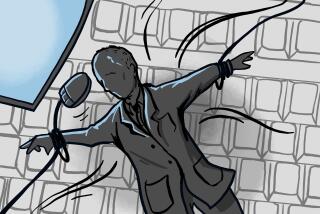Patients Are Now Finding That the Physician Assistant Is In
- Share via
Tom Harward has diagnosed heart disease, aneurysms, diabetes and depression. As he races through the small West Virginia town of Belington making house calls with his little black bag, he treats throat and ear infections and injects painkillers into cancer patients. Some people in this remote town call Harward “Dr. Tom.”
But he’s not a doctor.
At Prince George’s Hospital Center in Maryland, Bonnie DeMare’s beeper goes off at 6:30 p.m., alerting her that a patient is in respiratory failure in the critical care unit. She rushes to the unit, makes an incision in the patient’s chest and guides a tube into his lung to drain the fluid. She sutures the opening with neat stitches; the crisis has passed.
She’s not a doctor either.
Harward and DeMare are physician assistants (PAs), members of a booming profession that increasingly is filling a void in the country’s health care needs. Physician assistants are providing primary health care in rural areas where people have little access to doctors, in inner-city clinics where people have little money for health care, and in hospitals and private doctors’ offices where physicians caught up in the cost-cutting revolution of managed care have to see more patients in less time.
Walk into your neighborhood medical center with a bad sore throat, and it may be a physician assistant who listens to your heartbeat, looks down your throat and writes a prescription. Take your child to a pediatrician’s office, and the person in the white coat who diagnoses chickenpox may be a physician assistant.
*
In the last two years, the number of schools offering PA programs leaped 33%, from 64 to 85. And that’s just part of a long-term trend: In the last 10 years, the annual number of graduates from PA programs has nearly doubled to 2,500.
Although the medical profession is grappling with an overabundance of specialists, the demand for PAs continues to exceed the supply. About 85% were employed in their field within a year of graduation, according to the American Academy of Physician Assistants in Alexandria, Va., and the Bureau of Labor Statistics has predicted a growth rate of 50% above the norm through 2005. PAs can be licensed in 49 states (the lone holdout is Mississippi); 39 states, plus Washington and Guam, allow them to write prescriptions.
One reason for the popularity of PAs--there are about 29,000 practicing now--undoubtedly is cost: The median annual income of a PA in general practice is about half that of a doctor ($60,000 compared with $110,000). And the average tuition to earn a PA degree (about $21,000) is significantly less than that for a physician’s degree (about $80,000).
In the late 1960s and early 1970s, when the PA profession was in its infancy, questions were raised in medical circles about whether PAs would lower the quality of health care.
“Some critics thought the job of PA was not attractive because it was interposed between medicine and nursing,” Reginald Carter, chief of the division of Physician Assistant Education at Duke University, wrote in an article on the origins of the profession. “Others worried about the legality of PAs performing tasks traditionally carried out by physicians; and still others worried about PAs impersonating doctors and not knowing their own role limitations.”
Those concerns have lessened over the years, particularly after a National Academy of Sciences commission concluded last year that there was no difference between the quality of care given by a physician and a PA.
“The demand to hire physician assistants is at an all-time high,” said Richard Scheffler, a professor of health economics at UC Berkeley. In fact, “some patients prefer to go to physician assistants” rather than doctors, mainly because they spend more time with patients, he said. The hit television show “ER” features a PA who is HIV-positive and can be seen stitching wounds, setting bones and ordering tests, besides providing romantic interest.
In interviews, several PAs emphasized that they are not trying to be substitutes for doctors.
“It’s very important that we be defined as a physician-dependent profession,” Harward said. “We can’t function without supervision. I’m constantly reminding this profession not to forget its roots.”
Although the nearest full-time doctor practices 16 miles from Belington, two doctors visit Harward’s clinic two half-days a week, and he tries to schedule his most complex cases for those days.
“We’re the eyes and ears for the surgeon,” said DeMare, the PA in surgery and trauma at Prince George’s Hospital Center. That, she stressed, is quite different from being the surgeon.
Aside from the financial advantage, some in the medical profession see an added benefit in PAs: If managed care is forcing the humanity out of the medical profession, they say, PAs may be bringing it back.
Anthony Fasano, a family practitioner in Fairfax City, Va., hired a PA for half of what it would cost him to hire another doctor.
“I know physician colleagues of mine who book and double-book and see 35, 40 patients a day,” he said. “I think those patients are more likely to get short shrift. You can’t pick up on nuances unless you are there talking to a patient. PAs are especially good at taking histories.”
*
At Bon Secours Hospital in Baltimore, PA Dorothy Singletary oversees the transitional care unit, which serves as many as 32 patients who no longer need to see a physician every day but are not well enough to go home. Each day, Singletary makes rounds in St. Anne’s Continuing Care Center, dressing wounds, observing physical therapy and caring for patients who have had strokes, broken legs or other medical complications.
“When a rapport is developed because you have the time to sit and listen, you can communicate more effectively to the physician about all the things that are bothering the patient,” Singletary said. “Sometimes patients are a little afraid to tell the physician everything that is going on because they don’t think they can explain it well. Sometimes you have to help them out.”
On a recent day, Singletary spent 35 minutes talking with a man who had just transferred from another hospital.
“I went in and listened, and he just poured out everything. He felt nobody was telling him anything.
“I asked him what he understood about his medical condition. I explained his chart. He said he can’t sleep and he can’t breathe and he was chronically tired. I explained coughing medicine and sleeping medicine and that he has to ask for it and he would get it.
“I didn’t rush him. I pulled up a chair and just listened. Physicians don’t have the time. These patients need a lot of explanations.”
The next day, Singletary went back to see the man.
“I said, ‘How are you feeling?’
“He said, ‘Well, I’m feeling some better.’
“I said, ‘I could tell you were feeling better.’
“He said, ‘How?’
“I said, ‘You are smiling.’ ”
* For more information on physician assistants, write to the American Academy of Physician Assistants, 950 N. Washington St., Alexandria, VA 22314, or call (703) 836-2272, Ext. 3209. E-mail:aapa@aapa.org. Web site: https://www.aapa.org.
More to Read
Sign up for Essential California
The most important California stories and recommendations in your inbox every morning.
You may occasionally receive promotional content from the Los Angeles Times.













